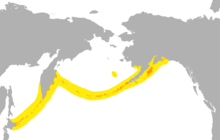Red-faced cormorant
The red-faced cormorant (Phalacrocorax urile), red-faced shag or violet shag, is a bird species of the family Phalacrocoracidae.
| Red-faced cormorant | |
|---|---|
 | |
| Scientific classification | |
| Kingdom: | Animalia |
| Phylum: | Chordata |
| Class: | Aves |
| Order: | Suliformes |
| Family: | Phalacrocoracidae |
| Genus: | Phalacrocorax |
| Species: | P. urile |
| Binomial name | |
| Phalacrocorax urile (Gmelin, 1789) | |
 | |
| Approximate range | |
Its range spans from the eastern tip of Hokkaidō in Japan, via the Kuril Islands, the southern tip of the Kamchatka Peninsula and the Aleutian Arc to the Alaska Peninsula and Gulf of Alaska.
The red-faced cormorant is closely related to the pelagic cormorant P. pelagicus, which has a similar range, and like the pelagic cormorant is placed by some authors (e.g. Johnsgaard) in a genus Leucocarbo. Where it nests alongside the pelagic cormorant, the red-faced cormorant generally breeds the more successfully of the two species, and it is currently increasing in numbers, at least in the easterly parts of its range. It is however listed as being of conservation concern[2], partly because relatively little is so far known about it.
The adult bird has glossy plumage that is a deep greenish blue in color, becoming purplish or bronze on the back and sides. In breeding condition it has a double crest, and white plumes on the flanks, neck and rump, and the bare facial skin of the lores and around the eyes is a bright orange or red, giving the bird its name; although the coloration is less vivid outside the breeding season, the red facial skin is enough to distinguish it from the otherwise rather similar pelagic cormorant. Its legs and feet are brownish black. Its wings range from 25 to 29 cm in extent, with females having on average about 5 cm shorter wings. Adults weigh between 1.5 and 2.3 kg, with females averaging 350 g less than males.
Analysis of stomach contents suggests that the red-faced cormorant is mainly a bottom feeder, taking cottids especially. Adults have few predators, though river otters may attempt to take them, as will corvids of various species, bald eagles and golden eagles. Gulls and corvids are common predators on eggs and chicks.
References
- BirdLife International (2012). "Phalacrocorax urile". IUCN Red List of Threatened Species. 2012. Retrieved 26 November 2013.CS1 maint: ref=harv (link)
- "RED-FACED CORMORANT Phalacrocorax urile" (PDF). U.S Fish & Wildlife Service.
- Johnsgaard, P. A. (1993). Cormorants, Darters and Pelicans of the World. Washington DC, Smithsonian Institution Press.
| Wikimedia Commons has media related to Phalacrocorax urile. |
